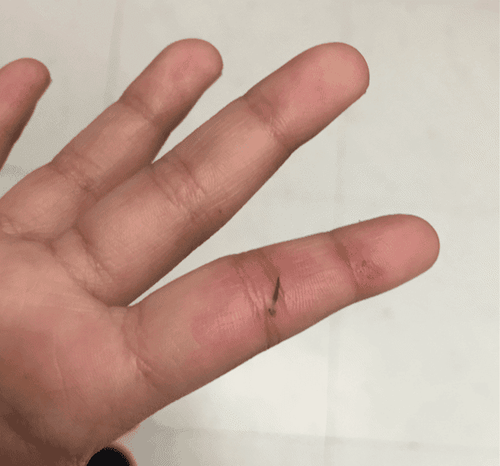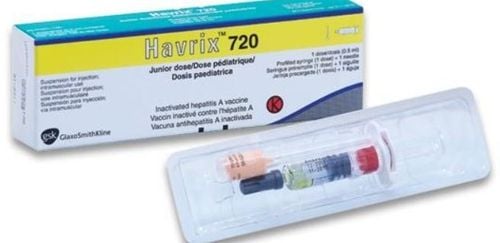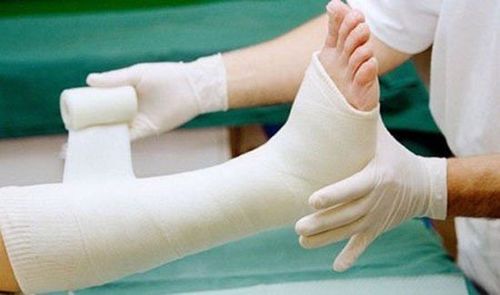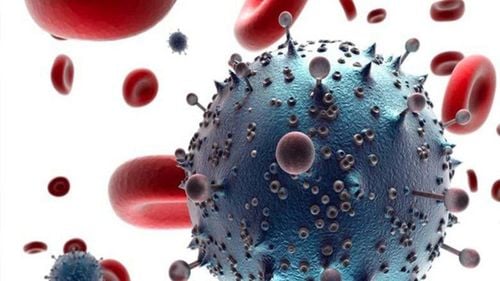This is an automatically translated article.
Children are not aware of the hazards that can injure them while playing and debris injuries are the most common result of these hazards. There are many materials such as wood, glass, plastic, and metal that can break into small pieces and pierce a child's skin when he or she is playful.Debris themselves are not harmful, but they can allow some harmful bacteria to enter your child's body and cause an infection. If children are not vaccinated in time, the risk of tetanus is very high. It is a potentially fatal infection for infants caused by bacteria entering the bloodstream through a wound. So how to remove the splinter from the child's hand? In this article, useful information will be provided to help caregivers promptly recognize and take effective measures.
1. What is the best way to remove splinters from baby's skin?
The best way is to use tweezers or a needle to remove most splinters like wood chips, glass shards, etc. at home. It is easier to remove the splinter before the skin begins to heal, and removing them early and cleaning the puncture site also helps to prevent the risk of infection in the baby.The first step should be to disinfect the needle or tweezers with alcohol, then wash your hands or skin with warm water and soap. Reassure your child that this is completely normal and that nearly all children will experience it at least once in their life. Once the prep is complete, place the baby on your lap or have someone else hold the baby while the mother tries to remove the splinter from the baby's skin. If the protrusion from the skin of the splinter is large enough, parents can use tweezers to gently pinch the base (where it emerges from the skin) and pull it straight out, taking care to pull them out in the same direction as they would. puncture to minimize damage in that area. In case the protrusion from the skin of the splinter is not large enough for a pair of tweezers to grasp, do not try as you could completely break the splinter and leave the splinter completely in the baby's skin.
In case the splinter is completely penetrated into the skin and no pieces protrude, use the sterilized needle method:
Soak the area in warm water for a few minutes to soften the skin. – unless it's wood chips, because chips soaked in warm water can swell and make it difficult to try to remove them. Using the needle, gently make an incision in the skin just above the part where the splinter entered and gently remove the splinter with sterilized tweezers through the incision. On the other hand, if a very small splinter is protruding, parents can remove it without needles or tweezers by:
Press firmly on a piece of tape then lift it. This will usually work with fragile debris - such as splinters from mistletoe or cactus thorns. Applying a layer of white glue on the punctured skin can also help in this case. Leave the glue on for five minutes then peel it off. Most of the small debris will be pulled out by the glue. Once the splinter is removed, parents should wash the area thoroughly with soap and warm water for the child. Next apply a thin layer of antibiotic ointment on it and cover the skin with sterile gauze. Clean the splinter area and reapply the ointment once a day until the wound is completely healed.

Cách tốt nhất là nên dùng nhíp hoặc đầu kim để loại bỏ hầu hết các mảnh dằm như mảnh vụn gỗ, mảnh thủy tinh... tại nhà
2. Should the child see a doctor in case of a splinter in the hand?
A lot of parents can't get the splinter out or the kids won't let their parents do it because they're afraid of pain. If it is a small splinter, parents can try to let it go away on its own for a few days. It is more likely that the splinter will be eliminated from the body on its own, especially when the baby is soaked in the bath and the warm water will soften the surrounding skin. However, this does not work with wood chips because as mentioned above, soaking in hot water can cause the wood chips to swell, causing pain to the child and making it difficult for the baby's body to expel them. than.Taking the child to a medical facility to be examined by a doctor is necessary in the following cases:
The splinter is too large and can cause the child to bleed a lot when removed Objects, debris have hooks, prongs, or bends Splinters that cause a child extreme pain Splinters that are under a child's fingernails or toenails that parents cannot reach. Splinters are in some other sensitive areas such as your baby's eyes Large splinters, such as a piece of wood, glass, or other debris, have pierced your baby's skin. The splinter causes a deep puncture and may need to be vaccinated against tetanus if infection is not wanted. Infection from splinter or splinter into the skin is not common, but parents do as well. Use extreme caution and take your child to a medical facility if you notice any of the following:
The punctured area is warm, hot, red, swollen or festering The child has a low-grade fever

Nếu trẻ bị dằm đâm vào sau mà sốt nhẹ hoặc khu vực bị đâm mưng mủ thì bạn nên đưa bé đến gặp bác sĩ
3. Are splinters ever dangerous to children?
Splinters are not usually dangerous to children, but there are special cases. If your baby is not vaccinated in time, a wound caused by a very small splinter can lead to tetanus, a dangerous infection with a high risk of death caused by bacteria entering the bloodstream directly. through an open wound.DTaP ((Diphtheria, Tetanus, Pertussis - Diphtheria, Tetanus, Pertussis) vaccine that protects against tetanus is usually given at the following times:
2 months old 4 months old 6 months old From 15 up to 18 months of age 4 to 6 years of age 11-12 years of age in TDaP, one booster shot After that recommended booster shot every 10 years for life Depending on size of splinter and condition A child's tetanus vaccination status can help doctors decide if a tetanus shot is needed.

Nếu bé không được tiêm phòng kịp thời thì vết thương gây ra bởi một mảnh dằm rất nhỏ cũng có thể khiến trẻ mắc bệnh uốn ván
4. Preventing splinters from hitting hands and feet in children
Here are some helpful tips for parents to prevent splintering in their children's hands or feet:Don't let your child go out without shoes (or in the case of children walking inside). If you accidentally break a vase, glass or glass, make sure to vacuum up all the smallest debris. Using a wet paper towel can help clear up tiny debris after sweeping and sucking up large pieces. Let your child put on shoes or slippers after breaking glass or glass on the floor even if the floor has been cleaned Make sure any wooden railings in the house and wooden toys are smooth and free of debris Check floors and outdoor furniture, such as picnic tables, for debris that may still be feverish Check children's playground areas Keep children away from dust bushes as well as plants with thorns or other potential causes of debris appearance. Tweezers, needles and antibiotic ointment are indispensable in every family's first aid kit. Parents need to make sure they are ready for any situation that may arise with their child. It's not uncommon for children to get splinter in their arms or legs. Most debris can be removed at home with just pliers and tweezers, even with tape or glue. It is important to keep the area of the skin clean both before and after removing the splinter to reduce the risk of infection. In some cases, such as the debris is too big or the puncture is too deep, parents should not try to remove them, but need to take the child to the nearest medical facility.
Thanks to the system of facilities, modern medical equipment, sterile space, minimizing the impact as well as the risk of disease spread, the Pediatrics Department at Vinmec Health System will bring satisfaction to patients. Highly appreciated by customers and experts in the industry with:
Gathering a team of leading doctors in Pediatrics: Including leading experts with high professional qualifications (professors, associate professors, doctorate, master), rich experience, worked in big hospitals like Bach Mai, 108.. The doctors are all well-trained, professional, have a heart - reach, understand young psychology. In addition to domestic pediatric specialists, the Department of Pediatrics also has the participation of foreign experts (Japan, Singapore, Australia, USA) who are always pioneers in applying the latest and most effective treatment regimens. . Comprehensive services: In the field of Pediatrics, Vinmec provides a series of continuous medical examination and treatment services from Newborn to Pediatric and Vaccine,... according to international standards to help parents take care of their baby's health from birth to childhood. Advanced techniques: Vinmec has successfully deployed many specialized techniques to make the treatment of difficult diseases in pediatrics more effective: neurosurgery - skull, stem cell transplant blood in cancer treatment. Professional care: In addition to understanding children's psychology, Vinmec also pays special attention to the children's play space, helping them to play comfortably and get used to the hospital's environment, cooperate in treatment, improve the efficiency of medical treatment.
Please dial HOTLINE for more information or register for an appointment HERE. Download MyVinmec app to make appointments faster and to manage your bookings easily.
Reference source: babycenter.com, momjunction.com












